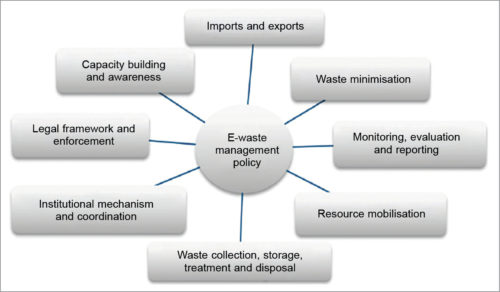The government of India has notified E-Waste (Management) Rules in 2016 and E-Waste (Management) Amendment Rules in 2018 for eco-friendly recycling and reducing e-waste.

After buying such electronic devices as smartphones and laptops, most people do not care what happens to the old ones. e-Waste is the term used for such discarded electronic items that are no longer considered useful. With old technologies becoming obsolete rapidly and new devices taking over the market at an exponential rate, the entire world is slowly becoming an electronics graveyard due to improper handling of waste.
Toxic substances are present in almost every electronic equipment, including hazardous metals like lead and cadmium in circuit boards, lead-oxide in cathode ray tubes (CRTs), mercury in monitors, beryllium in connectors and so on. Other miscreants are plastics, glass, ferrous and non-ferrous metals.
Conventional procedures like dumping e-waste in landfills, incineration and informal processing of waste cause numerous health, environmental and security issues. The huge amount of waste at landfills sometimes causes uncontrolled fires, too. These harmful substances when released in the environment create soil, water and air pollution on a large scale. Even people living near such sites, especially children and unborn babies, are prone to serious health problems like cancer and impaired cognitive functions.
When people sell old electronic and electrical equipment to scrap dealers, or when formal recycling facilities wish to further recover materials, the materials go to the unorganised sector where unskilled workers are involved in manually dismantling the products at low cost with little measures taken to ensure safety and health.
Also, if data in those devices is not completely erased, it can be easily retrieved, which compromises the security of the concerned individuals, organisations and governments.
Sometimes, manufacturers get involved in unauthorised repairs and modifications for upgrading the items. These practices usually happen in developing countries, who also have to bear the burden of wastes imported from developed countries for processing. The condition is so bad that Guiyu in China is infamously known as the e-waste capital of the world.
Several measures are being implemented and more can be further taken at different levels to handle the situation. When it comes to manufacturing, design of the product is of utmost importance. Waste can be prevented even before generation by using safer alternatives like biodegradable materials for hazardous materials or reducing quantities by ordering only when required.
Standardisation of materials and improving production processes are necessary to increase efficiency. For instance, some 3D printers made by using fused deposition modelling (FDM) technique can be easily recycled once they can no longer be used.
People have to simply ensure that they do not dump their used products with other household wastes, and only certified recyclers or dismantlers handle them. While donating or selling them to others, they should check that the products are in working condition. By preferring recycled materials, more jobs can be created in this sector. According to ‘Global E-waste Management Market Size, Market Share, Application Analysis, Regional Outlook, Growth Trends, Key Players, Competitive Strategies and Forecasts, 2018 To 2026’ report, global e-waste management market is expected to grow at a CAGR of 5.7 per cent during the forecast period from 2018 to 2026. Extra Carbon and Binbag are among the numerous companies that have already come up in this sector to aid people in India.
In formal processing, waste segregation is done at first to recover valuable materials beforehand using techniques like electrolysis, filtration, centrifugation, etc. Goods that can be reused are repaired and resold at a lower price. This way fewer products need to be manufactured annually, leading to lower greenhouse gas emissions.
Hazardous materials are separated and treated to reduce their harmfulness. If materials are recyclable, they can be easily converted into something useful again, thus decreasing waste stream concentration. Workshop Q, a manufacturing company in Jaipur, uses waste having eco-friendly materials to make household items.
Ministry of Environment, Forest and Climate Change, government of India, has notified E-Waste (Management) Rules in 2016 and E-Waste (Management) Amendment Rules in 2018 for eco-friendly recycling and reducing e-waste. Following this, companies like GreyOrange have taken up the responsibility to recycle and dispose of their products. Though a lot of initiatives are being taken, further adoption of strict regulations and more programmes to create awareness among the consumers is the need of the hour.






